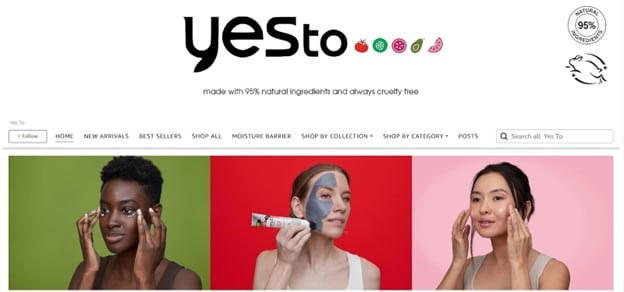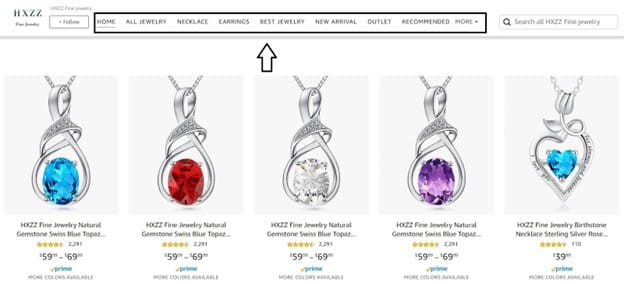Creating an Amazon storefront is one of the best methods to make the shopping process easier for customers. After all, Amazon has 310 million customers worldwide. With this impressive reach, it should be a priority to attract buyers, right?
It’s easy to navigate a storefront on Amazon. Plus, it looks more polished, and builds trust among your consumers. Plus, you can customize, brand, and personalize your store. But how do you make an Amazon storefront? And are there any requirements to know?
What Is an Amazon Storefront?
First, what is an Amazon storefront? It’s exactly what it sounds like–a devoted store that sellers use to organize their product listings.
An Amazon storefront looks like a typical e-commerce website, with a navigation bar and multiple pages that separate your products. You can also upload media, such as CTAs, banners, videos, images, and infographics, to make your storefront more captivating.

There are many benefits to opening a storefront, as we will cover in the next section. Some of Amazon store’s features include:
- Shoppable images
- Better product and inventory management
- The ability to add more media
- Your store URL
- Access to Amazon’s marketing capabilities
- Control over your store’s layout and design.
Benefits of Creating an Amazon Storefront
There are many advantages to opening an Amazon storefront, such as:
- Unique store URL
- It’s free to open an Amazon storefront
- Easy way to increase visibility
- More advertising and marketing opportunities
- Attract a wider audience
- Upselling and cross-selling
- Performance monitoring tools
- Improve conversion rates
Amazon storefronts are also beneficial to specific niches. For example, if you own a high-end fashion company, you can open luxury stores on Amazon to better target your niche.
That said, there are some downsides to opening an Amazon store. A storefront doesn’t do anything to improve your results on SERPs. You must already have a presence on Amazon, and there are some requirements to open a shop.
Amazon Storefront Requirements
There are two main requirements for an Amazon storefront setup:
- Enrolling in Amazon Brand Registry is always the first step in creating your Amazon storefront. You’ll need a registered trademark to enroll in the registry.
- The second step is to register your store’s trademark, you can easily apply for one in the country you’re based in or any you plan on selling to. The trademark must be image-based or text-based, and you can sign up while the trademark’s status is still pending, but it depends on the country. You can find a more thorough explanation here.
How to Open an Amazon Storefront
Are you interested in creating an Amazon storefront? Follow these steps to open your store on Amazon.
Step 1: Enroll in the Amazon Brand Registry Program
As stated previously, the first step in creating your storefront is enrolling in the Amazon Brand Registry program. This step is essential because it protects scammers from copying your brand and products. Amazon will offer additional tools to find knock-off and copycat products on the registry program.
To ensure you have legal protections, Amazon will need to see you have a registered (or, in some cases, pending) trademark. They will only accept trademarks from countries active in the World Intellectual Property Organization (WIPO).
When you enroll in the brand registry program, you’ll need this information:
- Store name
- Government-issued trademark number
- Countries that manufacture and/or distribute your products
- Product categories that best fit your items
Once you submit this information, Amazon will review your application. This may take as little as 24 hours or as long as a month.
Step 2: Create Your Store
Once you’re approved for the Amazon registry program and receive your verification code, you can create your storefront. Here are the steps:
- Click “storefront” on the main navigation bar of your Seller Central account
- Select “Create Store”
- Click the pop-up box and choose your store’s name
- Select “Create Store”
If you don’t see your brand’s name, it’s because you haven’t been approved for the brand registry yet. Check your approval status. If your brand registry approval is still pending, wait until acceptance. If you’ve been rejected, fix any problems before creating your Amazon storefront.
You’ll need to include your brand name and logo when you have been accepted. The logo should be 400 x 400 pixels.
Step 3: Select Your Template
Every Amazon store has a pre-designed template that serves as the backbone of your store. Several template options include a product highlight, marquee (highlights numerous products), and grid.
You can also choose the blank option and customize your template.
Don’t confuse your template with the store’s design. When you edit the store’s design, you’ll choose certain aspects that will make your store stand out, such as the images and video.
Regardless of the template you choose, all stores must provide a description. It’s best to keep your description simple and short, highlighting certain points, such as your products and business ethics.
Step 4: Customize the Design
Once you select your template, Amazon offers a drag-and-drop builder to customize every design aspect.
If you’re familiar with Wix’s web builder or the WordPress Gutenberg Editor, you can easily figure this step out. Amazon separates the area into multiple blocks. You can click each block to add products, text, images, or videos.
Each function has multiple editing features so that you can customize your design in even more ways.
Templates include a space for the hero image. It can be a product, a collection of products, or a branded lifestyle image. The hero image must be 3000 x 600 pixels.
Step 5: Create Your Product Catalog
Once you design the main storefront page, you can create your entire product catalog. The first place to start is with the menu. In Amazon’s hierarchy, pages separate your products based on category.
For example, if you sell jewelry, you can create separate pages for necklaces, earrings, bracelets, rings, etc. These pages appear on the menu bar, so customers can easily navigate your storefront and find the desired items.

Once you create your pages, upload individual products to the catalog. You’ll use the same process as you did for the design, clicking the tiles and uploading the products.
What if you want to add products you already uploaded? You have the option to search for the ASIN number or search for your products.
If you’re uploading new products, you must select the correct product category, write a description that includes the features and FAQs, and add high-quality images.
Step 6: Launch Your Store
Once you created your menu navigation bar and uploaded your products, you’re ready to launch your store. Preview your store first to ensure it’s what you envisioned. You can find the “Preview” button in the navigation bar.
After previewing and approving the store, click “Submit for Publishing.” Amazon will review your storefront, which can take up to 72 hours. If Amazon doesn’t approve your store, they will email you with any issues.
Strategies to Drive Sales
Once you create your storefront, there are many strategies to increase conversions and sales. These will help build your brand on (and off) Amazon.
Write High-Quality Descriptions
There are many reasons why well-written product descriptions increase conversion rates.
First, let’s discuss this from the buyer’s perspective. Amazon organizes your listing by features, a more in-depth description, and FAQs. Filling out these forms will help your buyer better understand your product, and this extra knowledge will increase trust.
We mentioned previously that a storefront doesn’t automatically improve your SEO performance, but a content marketing strategy can.
Optimizing your descriptions for different keywords can improve your performance on the SERPs, so you can stay ahead of the competition.
Are you struggling to write product descriptions? Or are you not getting results from your descriptions? Take a look at our content services.
Advertising
While organic tactics can increase traffic, advertising can boost visibility quicker. Amazon offers many advertising features, such as sponsored display ads.
When customers search for different queries, Amazon will display the ads that most correlate with the queries.
This is why investing in Amazon ads is an effective way to not only increase traffic but target your audience.
Influencer Marketing
Influencer marketing has skyrocketed in popularity and has since become an industry worth $21.1 billion. That’s because your customers trust influencers.
Influencer marketing offers more benefits than increased visibility and sales growth. When you collaborate with influencers, your social proof increases, fueling even more growth.
There are a couple of ways to find influencers on Amazon. Many stores start by working with Amazon associates, content creators who help advertise your products. They do this in exchange for a commission link, and earn compensation once users click on the URL.
The Amazon Influencer Program works similarly, but you’ll collaborate with specific influencers who have a larger following and are more established in their niche.
Create Your Amazon Storefront
With an Amazon storefront, you can engage your audience and increase sales. An Amazon storefront operates like a normal e-commerce store, separating your product catalog into different categories. You also get different perks, such as your URL.
You must first enroll in the brand registry program to create an Amazon storefront. From here, you can follow the steps to create a unique storefront for your brand.
Are you looking for other ways to improve your Amazon store’s growth? Take a look at our Accelerator Program.
Author

Stephanie Jensen has been writing e-commerce content for seven years, and her copy has helped numerous stores rank on Amazon. Follow her on LinkedIn for more insight into freelance writing and creating high-quality content.



